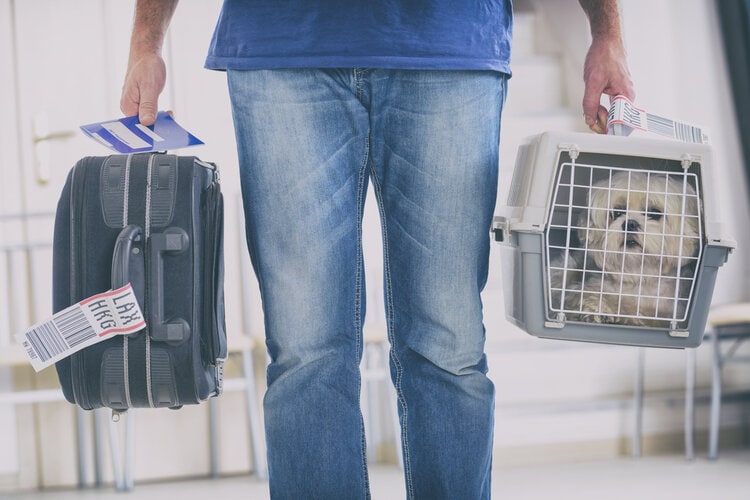- October 18, 2023
Traveling to Mexico With a Dog: 14 Vet-Reviewed Points To Consider



The information is current and up-to-date in accordance with the latest veterinarian research.
If you’re like many dog owners, you love taking your precious pet with you wherever you go. Traveling with your dog has become easier over the years, but traveling to another country is still rather difficult due to the many restrictions, laws, and regulations. But what about traveling with your dog to Mexico?
While it’s not without a few rules, traveling with your dog to Mexico became significantly easier in 2019. That’s when the Mexican government eased its restrictions and made bringing your dog into the country less of a hassle. We urge you to keep reading if you want to visit Mexico with your canine companion sometime soon. These 14 points will provide insight and helpful advice to make the trip more enjoyable.

The 14 Points to Consider When Traveling to Mexico With Your Dog
1. A Rabies Certificate Is Necessary to Cross Into Mexico
Although the restrictions to travel into Mexico with your dog have been eased, it’s still required that you have your dog’s rabies certificate when you visit the country. Remember that the border crossing patrol might not ask for the certificate at the border, but then again, they might.
If you don’t have the rabies certificate and you’re asked to present it, you will not be allowed to cross into Mexico. The information required on the certificate includes the following:
- Your name and address
- The breed, sex, age, and color of your dog
- The date the rabies vaccination was given
- The date the vaccination expires
- The name, license number, address, and signature of your veterinarian

2. A Health Certificate Is No Longer Needed to Visit Mexico With Your Dog
If you are traveling from the U.S.A. or Canada, one regulation no longer in place is the need for a health certificate to visit Mexico with your dog. Not needing a health certificate will save you time and money in the United States because you won’t need to go to your veterinarian to get one.
3. Up-to-Date Vaccine Records Might Be Necessary
Although you no longer need a health certificate to enter Mexico with your dog, bringing up-to-date vaccine records is still recommended. The records should be legible and show the dates when the vaccinations were given and any dates scheduled for future vaccinations. Below is a list of recommended vaccines when traveling to Mexico.
- Rabies
- Distemper
- Parvovirus
- Hepatitis
- Leptospirosis
- Parainfluenza
4. You Should Travel With All of Your Dog’s Veterinary and Medication Records
If the border officials want to see your dog’s veterinary and medication records, and you don’t have them, you might have to turn around and go home. That’s why it’s a good idea to travel with all of your dog’s veterinary records and a list of the medications that they’re taking (if any). You might never be asked to provide these records, but if you are, having them will certainly make things easier.

5. Expired Rabies Vaccination Certificates Are NOT Accepted When Returning to the U.S.
Some Americans mistakenly traveled to Mexico with a rabies vaccination certificate for their dog that’s close to expiring. When returning to the United States, if your dog’s rabies vaccination certificate has expired, you won’t be allowed back into the country with your pet. That could be a huge problem, so ensure their rabies certificate won’t expire when you’re there.
6. Mexico Is Not on the List of High-Risk Rabies Countries
The United States Center for Disease Control (CDC) has strict restrictions for bringing a dog into the country from countries with a high risk for rabies. Rabies is a deadly disease that can be transferred to humans. The good news is that Mexico is not on that list, and so many restrictions on bringing dogs back into the United States will not affect you when you visit Mexico.
7. Only Cats and Dogs Are Considered “Pets” in Mexico
This may not be important if you’re traveling to Mexico with your dog, but it’s good to know that the country only considers cats and dogs to be “pets.” So, for example, if you want to travel to Mexico with your pet ferret, rabbit, or guinea pig, the rules and restrictions will be completely different. You will need to get special permission and documentation and have an organized quarantine area in place, since those animals are considered “livestock.”

8. You Can Only Bring a Limited Supply of Dog Food
You can bring 50 pounds of sealed, bagged, and unopened dog food to Mexico. Depending on your dog’s size and food requirements, 50 pounds is typically enough for 2 weeks. Mexico carries many of the same brands, and the limit will only affect you if your dog is on a specialized diet. Dogs that can eat regular dog kibble won’t have a problem since you can find dog food in most Mexican grocery stores.
9. Your Dog Will Need an ISO-compatible Microchip to Return to the U.S.
To be allowed back into The United States, your dog will need an International Standards Organization (ISO) compatible microchip. It’s important to note that this microchip can come from any country, but it must be ISO-compatible. The US CDC recommends checking with your microchip company to ensure it is.
If you know that the microchip in your dog isn’t ISO-compatible, the US CDC allows you to bring your own scanner to read it when asked. If they can’t read the microchip, and you don’t have a scanner, your dog will not be allowed back into the United States.
10. Ehrlichiosis Is Common in Mexico’s Dog Population
You must have your dog treated for fleas and ticks before traveling to Mexico. One reason is that Ehrlichia cannis, a bacterium transferred to dogs by ticks, is commonly found in Mexican dog populations. Ehrlichia causes several outward signs, including fever, lethargy, nose bleeds, and decreased appetite. In severe cases, your dog can rapidly lose weight and have difficulty breathing. Ehrlichia can also affect your dog’s bone marrow, and in severe cases, it can be fatal.

11. You’re Supposed to Take Your Dog to Mexico’s OISA
When visiting Mexico with your dog, regulations in the country state that you need to visit the Mexican Animal and Plant Health Inspection Office (OISA), located at airports, upon entering the country.
12. Your Dog Needs to Be Inside a Transporter
To enter the country, your dog needs to arrive in a transporter, which will be sanitized during your dog’s arrival inspection. Beddings and toys are not allowed to be imported.
13. Most Mexican Airlines Still Require a Health Certificate
Even though you don’t need a health certificate to enter Mexico with your dog, most Mexican airlines still require the certificate to fly there. If you’re using a Mexican airline to travel into and out of Mexico, you must check ahead to see their regulations and make the proper arrangements for your dog. If the airline you’re using requires a health certificate, you’ll need to get one from your veterinarian before you leave.

14. Be Sure to Check If Your Lodgings Accept Dogs
The good news about traveling to Mexico with your canine companion is that most hotels, lodgings, and hostels accept dogs. However, it’s always best to check beforehand to make sure. We recommend calling the hotels since the information found on the internet is often incorrect. The last thing you want is to arrive at your lodgings with your pet only to be told that you can’t stay there.

Final Thoughts
Traveling to Mexico with your dog is much easier than it used to be, but you need to follow several rules and regulations. One of the most important is to have written proof that your dog has been vaccinated for rabies. Another is that you can only bring enough unsealed food for one day or 50 pounds of sealed, bagged, and unopened food with you on your trip.
Before traveling to Mexico with your dog, it’s best to have them vaccinated and treated for fleas, ticks, and heartworms. Having up-to-date documentation will make your trip to Mexico with your dog easier, less stressful, and much more enjoyable.
Featured Image Credit: Yekatseryna Netuk, Shutterstock
Tags
What do you think?
Related Articles

New Puppy Checklist: Gear You’ll Need for Your New Dog
Getting a new puppy is really exciting, but before you welcome them home, it’s important to prepare your space for them. Since puppies need a

How Big Do Mini Poodles Get? Vet Reviewed Average Weight & Growth Chart – Dogster
The information is current and up-to-date in accordance with the latest veterinarian research. Learn more » When you buy a Miniature Poodle, you might not

Can Police Dogs Smell Nicotine? Vet Verified Facts & Info – Dogster
The information is current and up-to-date in accordance with the latest veterinarian research. Learn more » While cigarette sales have been declining steadily for decades,

How Old Is 5 in Dog Years? Vet-Approved Guide to Each Size of Dog – Dogster
The information is current and up-to-date in accordance with the latest veterinarian research. Learn more » A common method for calculating a dog’s age is

